Papers by kulthida teachavorasinskun
Springer eBooks, Nov 18, 2022
Springer eBooks, Nov 18, 2022
Springer eBooks, Nov 18, 2022
Springer eBooks, Nov 18, 2022
Design for Enhancing Eco-efficiency of Energy-related Products

Though there are various electronic travel aids for people with visual disabilities, target users... more Though there are various electronic travel aids for people with visual disabilities, target users in some areas may not be able to afford one due to their high cost. This paper proposes a prototype of iSonar-2; a low-cost directional obstacle warning device using multiple ultrasonic transducers with a miniaturized, high performance. To avoid collision, four ultrasonic transducers with 40 kHz are used to detect obstacles within the range of the user's head and the ground, including stairs. iSonar-2 provides directional tactile feedback with six DC motors that vibrate in different position and frequencies, depending on the details of the obstacle's whereabouts and characteristics. The coverage area is 130 cm forward and 100 cm from each side. We evaluated the maximum scanning range and the performance of the system and found that iSonar-2 can reduce the average collision rate to 17.78%.
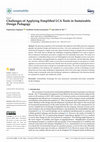
Sustainability, 2021
The growing recognition of the Sustainable Development Goals (SDGs) has been integrated globally ... more The growing recognition of the Sustainable Development Goals (SDGs) has been integrated globally into product design and business activities. Life cycle assessment (LCA) is considered a useful tool for designers to apply in the early stages of product design to mitigate the environmental impact. The study aims to identify the challenges of applying simplified LCA tools to improve the eco-efficiency of products and achieve a higher level of sustainable innovation. The study was conducted in a sustainable design course at Chulalongkorn University, Bangkok, for four consecutive years. All challenges and opportunities by using ECO-it, Eco-indicators, and the Materials, Energy use, and Toxic emissions (MET) matrix to assess the environmental impact in each phase of 11 home appliances are presented and discussed. Results show the positive potential of applying the tools to achieve function innovation in design for sustainable innovation. The needs for guided instruction, the availability ...
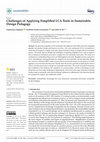
Sustainability , 2021
The growing recognition of the Sustainable Development Goals (SDGs) has been integrated globally ... more The growing recognition of the Sustainable Development Goals (SDGs) has been integrated globally into product design and business activities. Life cycle assessment (LCA) is considered a useful tool for designers to apply in the early stages of product design to mitigate the environmental impact. The study aims to identify the challenges of applying simplified LCA tools to improve the eco-efficiency of products and achieve a higher level of sustainable innovation. The study was conducted in a sustainable design course at Chulalongkorn University, Bangkok, for four consecutive years. All challenges and opportunities by using ECO-it, Eco-indicators, and the Materials, Energy use, and Toxic emissions (MET) matrix to assess the environmental impact in each phase of 11 home appliances are presented and discussed. Results show the positive potential of applying the tools to achieve function innovation in design for sustainable innovation. The needs for guided instruction, the availability of the database, the complexity of a study product, and the overlooking of social dimensions are four major challenges in applying the tools in the early stages of product redesign. Further study in testing the tools and developing a database in collaboration with industries should be conducted to compare and validate the results
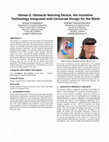
The iSonar-2 is a wearable travel aids product for the blind and visually impaired which aims to ... more The iSonar-2 is a wearable travel aids product for the blind and visually impaired which aims to prevent the anterior collision from head to lower body of the user. This paper proposes a prototype of iSonar-2; an affordable directional obstacle warning device using multiple ultrasonic transducers with the optimum miniaturized, high performance features. To avoid the collision, three ultrasonic transducers with 40 kHz are used to detect obstacles within the range of the user's head and the ground, including stairs. The iSonar-2 provides directional tactile feedback with three DC motors that vibrate in different position and frequencies, depending on the details of the obstacle's whereabouts and characteristics. The coverage areas are 130 cm and 100 cm anterior and lateral respectively. The design development objective is to enhance the usability with more accurate detection of environment as well as product pleasurable appearance for users.
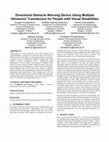
Though there are various electronic travel aids for people with visual disabilities, target users... more Though there are various electronic travel aids for people with visual disabilities, target users in some areas may not be able to afford one due to their high cost. This paper proposes a prototype of iSonar-2; a low-cost directional obstacle warning device using multiple ultrasonic transducers with a miniaturized, high performance. To avoid collision, four ultrasonic transducers with 40 kHz are used to detect obstacles within the range of the user's head and the ground, including stairs. iSonar-2 provides directional tactile feedback with six DC motors that vibrate in different position and frequencies, depending on the details of the obstacle's whereabouts and characteristics. The coverage area is 130 cm forward and 100 cm from each side. We evaluated the maximum scanning range and the performance of the system and found that iSonar-2 can reduce the average collision rate to 17.78%.
[[Mestyle Home and Living Magazine pp.130-133 March 2014]
กว่าหนึ่งทศวรรษที่ โตโยต้ายูนิเวอร์แซลด... more [[Mestyle Home and Living Magazine pp.130-133 March 2014]
กว่าหนึ่งทศวรรษที่ โตโยต้ายูนิเวอร์แซลดีไซน์
โชว์เคส ที่ประเทศญี่ปุ่น ได้เปิดให้ผู้เข้าชมนิทรรศการ
ได้รับความรู้ ความเข้าใจหลักการออกแบบสากล
ที่ประเทศสหรัฐอเมริกาเป็นต้นกำเนิดแนวคิด
เมื่อประมาณยี่สิบปีที่แล้ว

“เรียนรู้การออกแบบรถไฟฟ้ าความเร็วสูงญี่ปุ่ น เรียนรู้ผ่านการออกแบบองค์รวมของเอย์จิ มิโตโอกะ” วารสารวิชาการคณะสถาปัตยกรรมศาสตร์ จุฬาลงกรณ์มหาวิทยาลัย ปี การศึกษา 2556: 25 – 44., Dec 2013
ABSTRACT
Keywords:
design identity, artisan, socio-cultural context, design for quality of life... more ABSTRACT
Keywords:
design identity, artisan, socio-cultural context, design for quality of life, holistic design.
In order to understand Japanese design philosophy that elevates the experience of pleasure from the physical aspect to the psychological aspect, is to learn on the basis of the changes caused by economic factor, advanced technology factor, Japanese design identities factor which prospers by Japanese artisan, as well as the awareness of the physio-psychological differences of users that affected the utility and preference in Japanese cultural context. The attractiveness of Eiji Mitooka’s design is his mastering in integrating the vernacular wisdom and craftsmanship with local material under manufacturing condition for the way of life nowadays. By creating a new dimension of engaging all stakeholders, i.e., user-manufacturer-entrepreneur, the concrete design for quality of life was achieved with regard to local resource, technological progression, and business vision. Eiji Mitooka’s holistic design approach presents the important role of the industrial designers toward society.
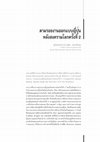
““ตามรอยงานออกแบบญี่ปุ่นหลังสงครามโลกครั้งที่ 2”. วารสารวิชาการคณะสถาปัตยกรรมศาสตร์ จุฬาลงกรณ์มหาวิทยาลัย ปีการศึกษา 2552: 1 – 8., 2009
บทความนี้เป็นรายงานการศึกษาเบื้องต้นของโครงการวิจัยภายใต้โครงการรูปธรรมศึกษาฯ คณะสถาปัตยกรรมศาสต... more บทความนี้เป็นรายงานการศึกษาเบื้องต้นของโครงการวิจัยภายใต้โครงการรูปธรรมศึกษาฯ คณะสถาปัตยกรรมศาสตร์ จุฬาลงกรณ์มหาวิทยาลัย ชื่อโครงการ การสร้างแผนที่ทบทวน: งานออกแบบญี่ปุ่นหลังสงครามโลกครั้งที่ 2 จากมุมมองไทย (Redraw Mapping: Japanese Design after World War II from Thai Perspective)
จากการศึกษางานออกแบบญี่ปุ่นหลังสงครามโลกครั้งที่ 2 ในเบื้องต้นพบว่าการรับรู้งานออกแบบญี่ปุ่นในสังคมปัจจุบัน เป็นการสืบทอดแนวความคิดที่มีผลจากอิทธิพลของมุมมองจากตะวันตก โดยอาจเป็นผลสืบเนื่องจากความพยายามถ่ายทอดภาพลักษณ์ของญี่ปุ่นเองต่อโลกภายนอก ตั้งแต่ยุคที่มีการแผ่ขยายอาณานิคมตะวันตกมายังกลุ่มประเทศเอเชีย จึงเป็นที่มาของการศึกษาบริบทการออกแบบของญี่ปุ่นหลังสงครามโลกครั้งที่ 2 ผ่านมุมมองไทย อาศัยการทบทวนวรรณกรรม การสืบค้นจากสื่อสารสนเทศ สื่อภาพยนตร์ การ์ตูน และการเข้าร่วมการประชุมและการสัมนาเชิงปฏิบัติการที่เกี่ยวข้องกับงานออกแบบญี่ปุ่น เกิดเป็นแนวความคิดในการแบ่งประเภทขององค์ประกอบในการศึกษาเบื้องต้นเป็นมุมมอง 2 ด้านที่ยืดหยุ่นและอาจมีขอบเขตเหลื่อมล้ำกัน ได้แก่ มุมมองด้านสุนทรียะ และ มุมมองด้านสังคม เศรษฐกิจ และ เทคโนโลยี ผลที่ได้จากการคึกษาอัตลักษณ์งานออกแบบญี่ปุ่นจากมุมมองทั้งสองด้าน ก่อให้เกิดความรู้ ความเข้าใจในแง่มุมที่หลากหลายและซับซ้อนขององค์ประกอบความเป็นญี่ปุ่น นอกเหนือไปจากเนื้อหาในผลงานการออกแบบ ที่เกิดจากการสร้างสรรค์ทั้งโดยศิลปิน ช่างฝีมือ นักออกแบบ ตลอดจนผู้สร้างนิรนาม สามารถอธิบายผลการศึกษาโดยเสนอแนวความคิดในการสร้างแผนที่แสดงบริบทงานออกแบบญี่ปุ่นหลังสงครามโลกครั้งที่ 2 บนแกนอ้างอิงเชิงเวลา และแกนอ้างอิงด้านสุนทรียะ ด้านสังคม เศรษฐกิจ และ เทคโนโลยี เพื่อเป็นประโยชน์ต่อการศีกษาค้นคว้าต่อไป











Uploads
Papers by kulthida teachavorasinskun
กว่าหนึ่งทศวรรษที่ โตโยต้ายูนิเวอร์แซลดีไซน์
โชว์เคส ที่ประเทศญี่ปุ่น ได้เปิดให้ผู้เข้าชมนิทรรศการ
ได้รับความรู้ ความเข้าใจหลักการออกแบบสากล
ที่ประเทศสหรัฐอเมริกาเป็นต้นกำเนิดแนวคิด
เมื่อประมาณยี่สิบปีที่แล้ว
Keywords:
design identity, artisan, socio-cultural context, design for quality of life, holistic design.
In order to understand Japanese design philosophy that elevates the experience of pleasure from the physical aspect to the psychological aspect, is to learn on the basis of the changes caused by economic factor, advanced technology factor, Japanese design identities factor which prospers by Japanese artisan, as well as the awareness of the physio-psychological differences of users that affected the utility and preference in Japanese cultural context. The attractiveness of Eiji Mitooka’s design is his mastering in integrating the vernacular wisdom and craftsmanship with local material under manufacturing condition for the way of life nowadays. By creating a new dimension of engaging all stakeholders, i.e., user-manufacturer-entrepreneur, the concrete design for quality of life was achieved with regard to local resource, technological progression, and business vision. Eiji Mitooka’s holistic design approach presents the important role of the industrial designers toward society.
จากการศึกษางานออกแบบญี่ปุ่นหลังสงครามโลกครั้งที่ 2 ในเบื้องต้นพบว่าการรับรู้งานออกแบบญี่ปุ่นในสังคมปัจจุบัน เป็นการสืบทอดแนวความคิดที่มีผลจากอิทธิพลของมุมมองจากตะวันตก โดยอาจเป็นผลสืบเนื่องจากความพยายามถ่ายทอดภาพลักษณ์ของญี่ปุ่นเองต่อโลกภายนอก ตั้งแต่ยุคที่มีการแผ่ขยายอาณานิคมตะวันตกมายังกลุ่มประเทศเอเชีย จึงเป็นที่มาของการศึกษาบริบทการออกแบบของญี่ปุ่นหลังสงครามโลกครั้งที่ 2 ผ่านมุมมองไทย อาศัยการทบทวนวรรณกรรม การสืบค้นจากสื่อสารสนเทศ สื่อภาพยนตร์ การ์ตูน และการเข้าร่วมการประชุมและการสัมนาเชิงปฏิบัติการที่เกี่ยวข้องกับงานออกแบบญี่ปุ่น เกิดเป็นแนวความคิดในการแบ่งประเภทขององค์ประกอบในการศึกษาเบื้องต้นเป็นมุมมอง 2 ด้านที่ยืดหยุ่นและอาจมีขอบเขตเหลื่อมล้ำกัน ได้แก่ มุมมองด้านสุนทรียะ และ มุมมองด้านสังคม เศรษฐกิจ และ เทคโนโลยี ผลที่ได้จากการคึกษาอัตลักษณ์งานออกแบบญี่ปุ่นจากมุมมองทั้งสองด้าน ก่อให้เกิดความรู้ ความเข้าใจในแง่มุมที่หลากหลายและซับซ้อนขององค์ประกอบความเป็นญี่ปุ่น นอกเหนือไปจากเนื้อหาในผลงานการออกแบบ ที่เกิดจากการสร้างสรรค์ทั้งโดยศิลปิน ช่างฝีมือ นักออกแบบ ตลอดจนผู้สร้างนิรนาม สามารถอธิบายผลการศึกษาโดยเสนอแนวความคิดในการสร้างแผนที่แสดงบริบทงานออกแบบญี่ปุ่นหลังสงครามโลกครั้งที่ 2 บนแกนอ้างอิงเชิงเวลา และแกนอ้างอิงด้านสุนทรียะ ด้านสังคม เศรษฐกิจ และ เทคโนโลยี เพื่อเป็นประโยชน์ต่อการศีกษาค้นคว้าต่อไป
กว่าหนึ่งทศวรรษที่ โตโยต้ายูนิเวอร์แซลดีไซน์
โชว์เคส ที่ประเทศญี่ปุ่น ได้เปิดให้ผู้เข้าชมนิทรรศการ
ได้รับความรู้ ความเข้าใจหลักการออกแบบสากล
ที่ประเทศสหรัฐอเมริกาเป็นต้นกำเนิดแนวคิด
เมื่อประมาณยี่สิบปีที่แล้ว
Keywords:
design identity, artisan, socio-cultural context, design for quality of life, holistic design.
In order to understand Japanese design philosophy that elevates the experience of pleasure from the physical aspect to the psychological aspect, is to learn on the basis of the changes caused by economic factor, advanced technology factor, Japanese design identities factor which prospers by Japanese artisan, as well as the awareness of the physio-psychological differences of users that affected the utility and preference in Japanese cultural context. The attractiveness of Eiji Mitooka’s design is his mastering in integrating the vernacular wisdom and craftsmanship with local material under manufacturing condition for the way of life nowadays. By creating a new dimension of engaging all stakeholders, i.e., user-manufacturer-entrepreneur, the concrete design for quality of life was achieved with regard to local resource, technological progression, and business vision. Eiji Mitooka’s holistic design approach presents the important role of the industrial designers toward society.
จากการศึกษางานออกแบบญี่ปุ่นหลังสงครามโลกครั้งที่ 2 ในเบื้องต้นพบว่าการรับรู้งานออกแบบญี่ปุ่นในสังคมปัจจุบัน เป็นการสืบทอดแนวความคิดที่มีผลจากอิทธิพลของมุมมองจากตะวันตก โดยอาจเป็นผลสืบเนื่องจากความพยายามถ่ายทอดภาพลักษณ์ของญี่ปุ่นเองต่อโลกภายนอก ตั้งแต่ยุคที่มีการแผ่ขยายอาณานิคมตะวันตกมายังกลุ่มประเทศเอเชีย จึงเป็นที่มาของการศึกษาบริบทการออกแบบของญี่ปุ่นหลังสงครามโลกครั้งที่ 2 ผ่านมุมมองไทย อาศัยการทบทวนวรรณกรรม การสืบค้นจากสื่อสารสนเทศ สื่อภาพยนตร์ การ์ตูน และการเข้าร่วมการประชุมและการสัมนาเชิงปฏิบัติการที่เกี่ยวข้องกับงานออกแบบญี่ปุ่น เกิดเป็นแนวความคิดในการแบ่งประเภทขององค์ประกอบในการศึกษาเบื้องต้นเป็นมุมมอง 2 ด้านที่ยืดหยุ่นและอาจมีขอบเขตเหลื่อมล้ำกัน ได้แก่ มุมมองด้านสุนทรียะ และ มุมมองด้านสังคม เศรษฐกิจ และ เทคโนโลยี ผลที่ได้จากการคึกษาอัตลักษณ์งานออกแบบญี่ปุ่นจากมุมมองทั้งสองด้าน ก่อให้เกิดความรู้ ความเข้าใจในแง่มุมที่หลากหลายและซับซ้อนขององค์ประกอบความเป็นญี่ปุ่น นอกเหนือไปจากเนื้อหาในผลงานการออกแบบ ที่เกิดจากการสร้างสรรค์ทั้งโดยศิลปิน ช่างฝีมือ นักออกแบบ ตลอดจนผู้สร้างนิรนาม สามารถอธิบายผลการศึกษาโดยเสนอแนวความคิดในการสร้างแผนที่แสดงบริบทงานออกแบบญี่ปุ่นหลังสงครามโลกครั้งที่ 2 บนแกนอ้างอิงเชิงเวลา และแกนอ้างอิงด้านสุนทรียะ ด้านสังคม เศรษฐกิจ และ เทคโนโลยี เพื่อเป็นประโยชน์ต่อการศีกษาค้นคว้าต่อไป
อยู่ดีด้วย UD การออกแบบเพื่อสังคมน่าอยู่
ผู้แต่ง : กุลธิดา เตชวรสินสกุล
ผู้แปล :
Barcode : 9789740338291
ISBN : 9789740338291
ปีพิมพ์ : 1 / 2561
ขนาด (w x h) : 0 x 0 mm.
ปก / จำนวนหน้า : ปกอ่อน / 216 หน้า